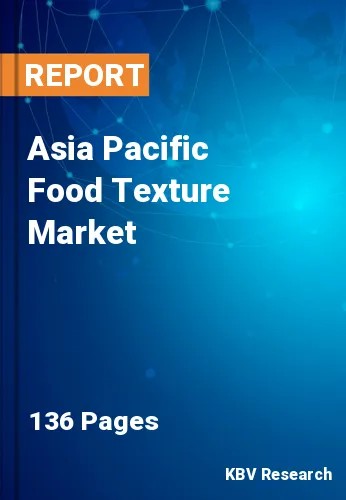The Asia Pacific Food Texture Market would witness market growth of 6.2% CAGR during the forecast period (2023-2030).
Working with food producers is a strategic opportunity for businesses in the market. By working closely with manufacturers, texture solution providers can more effectively satisfy their needs and provide unique texture solutions for their products. The creation of distinctive textures and product differentiation in the marketplace are made possible by this cooperation technique. There is a lot of potential for research & development into materials that improve texture. The study of developing novel chemicals that can alter or improve textures while maintaining clean labels and natural ingredient standards is an emerging field.
Examples of texture-altering inventions that offer opportunities for companies to increase their market penetration include hydrocolloids, emulsifiers, and stabilizers. The tongue, palate, teeth, and fingers can all feel for food texture, which indicates food quality. The criteria include chewability, adhesiveness, cohesiveness, crispiness, elasticity, and firmness. Texture analysis tests are used to examine how the products respond when food products are subjected to forces including shearing, cutting, chewing, compressing, and stretching. These tests all aid the investigation of the mechanical and physical properties of raw materials, the structure of foods, and designs for pre-and post-production quality checks. Various food texture additives have been utilized to enhance the overall flavor and feel of the products.
Asia’s snacking trends are evolving. At the same time, there is a significant increase in low-sugar, low-carb, and low-fat snack options. Consumers desire comforting, convenient refreshments, and many are actively pursuing wholesome, delicious products. In Asia-Pacific, a faster-paced lifestyle is being shaped by urbanization and the rise of new family structures. Many Millennials and Generation Z are relocating to densely populated cities for employment opportunities as urbanization increases. Since Asia Pacific becomes more urbanized and modern grocery retailers become more developed, consumers are transitioning from consuming unpackaged snacks at home or purchasing traditional street snacks from food cycles or trucks to having readily accessible packaged snacks. Consequently, the growth prospects for the market in the region are anticipated to increase significantly.
The China market dominated the Asia Pacific Food Texture Market by Country in 2022 and would continue to be a dominant market till 2030; thereby, achieving a market value of $1,646.4 million by 2030. The Japan market is registering a CAGR of 5.5% during (2023 - 2030). Additionally, The India market would showcase a CAGR of 6.9% during (2023 - 2030).
Based on Application, the market is segmented into Dairy Products & Ice Creams, Confectionery, Jams, Layers, Fillings, Bakery, Ready Meals, Beverage, Meat Products and Sauces & Others. Based on Product, the market is segmented into Natural and Synthetic. Based on Type, the market is segmented into Cellulose Derivatives, Gums, Inulin, Gelatins, Starch, Dextrins and Pectins & Others. Based on countries, the market is segmented into China, Japan, India, South Korea, Singapore, Malaysia, and Rest of Asia Pacific.
Free Valuable Insights: The Worldwide Food Texture Market is Projected to reach USD 20.5 Billion by 2030, at a CAGR of 5.5%
The market research report covers the analysis of key stake holders of the market. Key companies profiled in the report include Koninklijke DSM N.V., Archer Daniels Midland Company, Desosen Biochemical (Ordos) Ltd., Ingredion Incorporated, Kerry Group PLC, Jungbunzlauer Suisse AG, CP Kelco, Cargill, Incorporated, DuPont de Nemours, Inc. and Euroduna Food Ingredients GmbH
By Application
By Product
By Type
By Country
Our team of dedicated experts can provide you with attractive expansion opportunities for your business.

